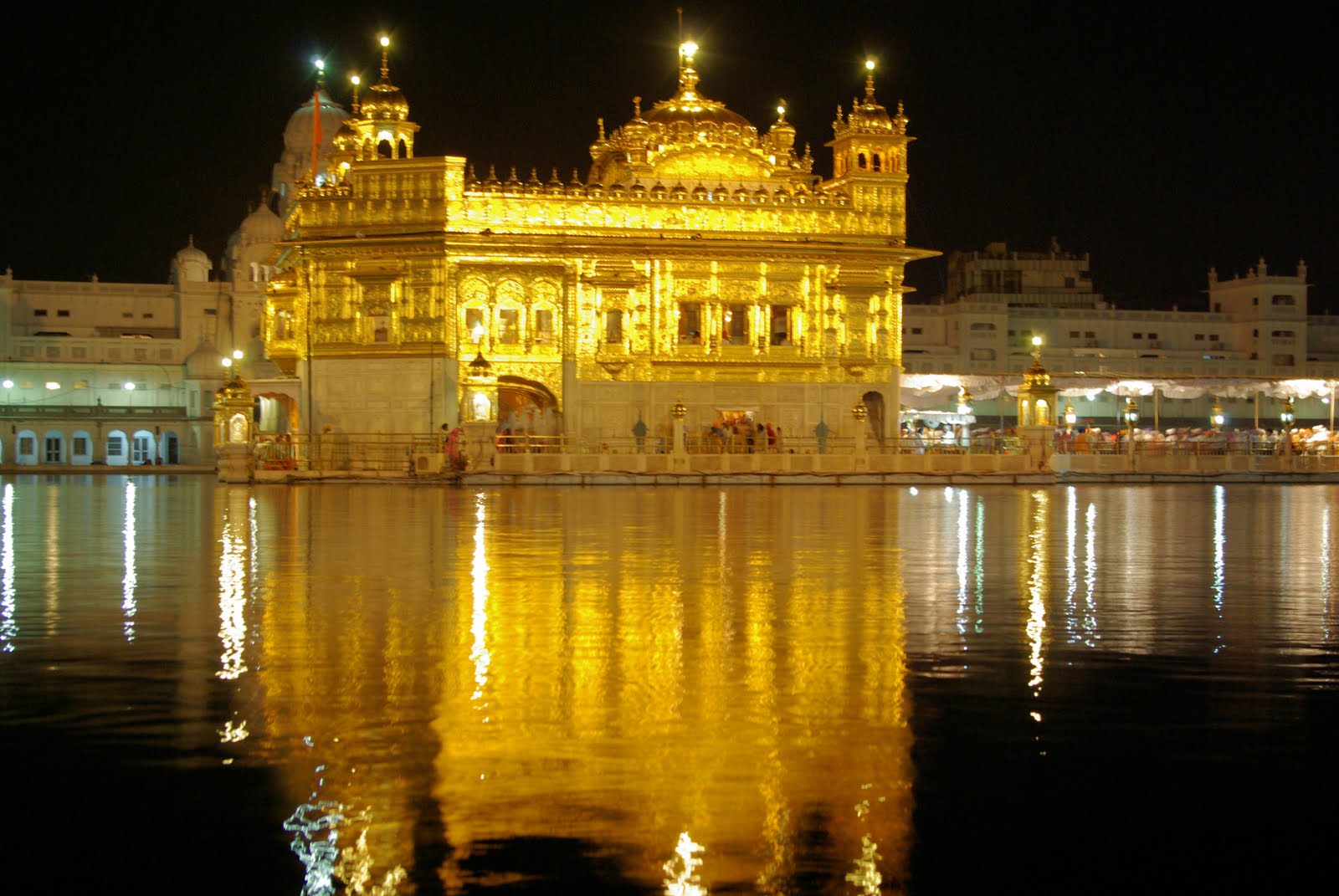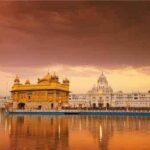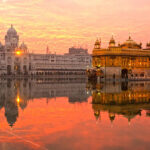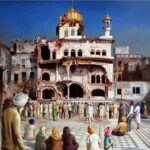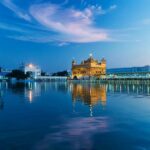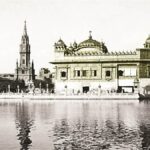The Temple of Gold (also known as Harmandir Sahib, lit. ‘the abode of God’, Punjabi pronunciation: [ɦəɾᵊmən̪d̪əɾᵊ saːɦ (ɪ) bᵊ], or Darbār Sahib, ‘the highest court’, [dbɾɾɾɾɾɾɾɾɾɾɾɾɾɾɾɾɾɾɾɾɾɾɾɾɾɾgib, the highest court. -gurdwara is located in the city of Amritsar, Punjab, India. It is a prominent spiritual site for Sikhism.
The name Harmandir means House for Everyone. The man who made the pool (Sarovar) representing the tradition was completed by the fourth Sikh Guru, Guru Ram Das, in 1577. In 1604, Guru Arjan placed a copy of Adi Granth in Harmandir Sahib. Gurdwara was rebuilt repeatedly by the Sikhs after being the victim of persecution and was repeatedly destroyed by Mughal forces and invading Afghan soldiers. Maharaja Ranjit Singh, after the founding of the Sikh Empire, rebuilt it with marble and bronze in 1809 and adorned the sanctum with a gold leaf in 1830. This has led to the name of the Temple of Gold.
The Spiritual Gold Temple is the most important holy place in Sikhism. It became the center of the Singh Sabha Movement between 1883 and 1920, and the Punjabi Suba movement between 1947 and 1966. In the early 1980s, Gurdwara became the center of conflict between the Indian government led by Indira Gandhi, some strong Sikh factions, and the Jarnail Singh Bhindranwale movement. In 1984, Prime Minister Indira Gandhi enlisted in the Indian Army as part of Operation Blue Star, which resulted in the deaths of more than 1,000 soldiers and civilians, as well as extensive damage to Gurdwara and the destruction of Akal Takht. The Gurdwara area was rebuilt after the 1984 devastation.
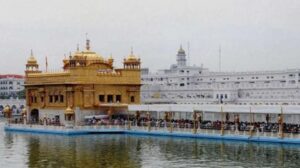
The Golden Temple is an open house of worship for all people, from all walks of life and religions. It has a square system with four doors, and a way around the pool. The building is a collection of structures around the sanctum and lake. One of these is Akal Takht, a major center for religious authority in Sikhism. Additional facilities include a clock tower, Gurdwara Committee offices, Museum, and langar – a free community-owned Sikh kitchen that provides a vegetarian meal for all guests without discrimination. More than 100,000 people visit the sanctuary daily for worship. The Gurdwara area has been designated a UNESCO World Heritage Site, and its use is pending on UNESCO’s suspended list.
Harmandar Sahib is also known as Harmandir, or Harmandir Sahib. It is also called the Durbār Sahib, meaning “holy audience”, and the Golden Temple with its golden center covered with leaves. The word “Harmandir” is composed of two words: “Har”, which scholars translate as “Everyone”, and “mandir”, meaning “house”. The Sikh tradition has several Gurdwara named “Harmandir Sahib”, such as those in Kiratpur and Patna. Of these, Amritsar is highly regarded.
History
Interior Durbar Sahib with walls covered with gold and a gold chandelier
According to Sikh historical records, the land that became the Amritsar and the houses of Harimandir Sahib was chosen by Guru Amar Das, the third Heritage of the Sikh culture. It was then renamed Guru Da Chakk, after which he asked his student Ram Das for a place to start a new town with a man-made lake as its main location. After Guru Ram Das succeeded Guru Amar Das in 1574, despite fierce opposition from the sons of Guru Amar Das, Guru Ram Das founded a city known as “Ramdaspur”. He began by completing the pool with the help of Father Buddha (not to be confused with Buddhist Buddhism). Guru Ram Das built his new official center and home near it. He invited merchants and artisans from other parts of India to stay with him in the new city.
The city of Ramdaspur grew during the time of Guru Arjan, funded by donations, and was built voluntarily. The village grew into the city of Amritsar, and the area grew into a temple complex). The construction work between 1574 and 1604 is described in Mahima Prakash Vartak, a Sikh hagiography documentary dating to about 1741, and a well-known ancient documentary about the lives of all ten Heritagemen. Guru Arjan incorporated Sikhism inscription into the new gurdwara in 1604. Continuing the efforts of Guru Ram Das, Guru Arjan established Amritsar as the main center for the Sikh pilgrimage. He wrote a large number of Sikh texts including the popular Sukhmani Sahib.
Construction
Maharaja Ranjit Singh listened to the Guru Granth Sahib recited near Akal Takht and the Golden Temple, Amritsar, Punjab, India.
Guru Ram Das has found a site for this site. There are two kinds of stories about how you got this land. Elsewhere, based on the Gazetteer record, the property was purchased with 700 Sikh donations from the owners of the village of Tung. In another version, Emperor Akbar is said to have donated land to Guru Ram Das’ wife. In 1581, Guru Arjan began construction on Gurdwara. During the construction of the pond, it was kept empty and dry. It took eight years to complete the first version of Harmandir Sahib. Guru Arjan organized gurdwara at a lower level than the city to emphasize the humility and need to eliminate the human ego before entering the premises to meet Guru. He also called for the gurdwara compound to be open on all sides to ensure that it is open to the public. The sanctum inside the lake where Guru’s chair was located, had only one bridge to emphasize that the ultimate goal was one, says Arvind-Pal Singh Mandair. In 1589, the gurdwara made of bricks was completed. Guru Arjan is believed to have been the subject of some recent sources inviting Sufi saint Mian Mir of Lahore to lay the foundation stone, indicating that the Sikh culture is widely accepted. [1] This belief, however, is unproven. According to traditional Sikh sources such as the Sri Gur Suraj Parkash Granth, it was established by Guru Arjan himself. After the dedication, the pool was flooded. On August 16, 1604, Guru Arjan completed the expansion and compilation of the first Sikh text and placed a copy of Adi Granth on gurdwara. He chose Father Buddha as the first Grant.
Ath Sath Tirath, meaning “holy place for 68 travelers“, is a raised canopy in the park (marble path around the lake). The name, as pronounced W. Owen Cole, along with other scholars, demonstrates the belief that a visit to this temple is equivalent to 68 Hindu pilgrimages to the Indian subcontinent, or that the Tirath to the Golden Temple has the potential for all 68 Tirath combined. The completion of the first version of the Golden Temple was a major milestone in Sikhism, says Arvind-Pal Singh Mandarir, as it provided a central pilgrimage to the Sikh community and a meeting place for the Sikh community, located between the center of commerce and work.
The Golden Temple of the Night
The destruction of the Mughal Empire and the reconstruction-
Guru Arjan’s growing influence and success attracted the attention of the Mughal Empire. Guru Arjan was detained under the orders of the Mughal emperor Jahangir and asked to convert to Islam. [32] He refused, was tortured, and executed in 1606 CE. [32] [33] [34] The son and successor of Guru Arjan Guru Hargobind left Amritsar and moved to Shivalik Hills to avoid persecution and to save the Sikh way. [35] Nearly a century after the death of Guru Arjan, in the province of Louis E. Fenech and WH McLeod, the Golden Temple was not inhabited by true Sikh Guru and lived in the hands of hostile sects. [35] In the 18th century, Guru Gobind Singh and his newly formed Khalsa Sikhs returned and fought for liberation. [35] The Temple of Gold was regarded by the Mughal rulers and the Afghan Sultans as the seat of the Sikh faith and remained the target of persecution.
The Temple of Gold was the center of historical events in Sikh history
In 1709, the governor of Lahore sent his army to suppress and prevent the Sikhs from assembling in their Vaisakhi and Diwali celebrations. But the Sikhs despise gathering in the Temple of Gold. In 1716, Banda Singh and many Sikhs were arrested and executed.
In 1737, the Mughal ruler ordered the capture of the Golden Temple keeper, Mani Singh, and executed him. He appointed Masse Khan as a police commissioner who then resided in the Temple and turned it into a dance club with girls dancing. He polluted the pond. The Sikhs retaliated against the sanctity of the Golden Temple by assassinating Masse Khan inside the Temple in August 1740.
In 1746, another Lahore official, Diwan Lakhpat Rai, who worked for Yahiya Khan, and seeking revenge for his brother’s death, filled the pool with sand. In 1749, the Sikhs reclaimed the lake when Muin ul-Mulk reduced Mughal rule against the Sikhs and sought their help while working for the Multan.
In 1757, Afghan emperor Ahmad Shah Durrani, also known as Ahmad Shah Abdali, attacked Amritsar and desecrated the Golden Temple. He dumped rubbish in the lake and the intestines of slaughtered cattle, before heading to Afghanistan. The Sikhs restored it.
In 1762, Ahmad Shah Durrani returned and set fire to the Golden Temple. The Sikhs have returned and celebrated Diwali in their place. In 1764, Father Jassa Singh Ahluwalia collected donations to rebuild the Golden Temple. The main new gate (Darshan Deorhi), the main road, and the sanctum were completed in 1776, while the floor around the lake was completed in 1784. The Sikhs also completed the canal to bring fresh water from the Ravi River to bring to the lake.
Reconstruction of the Ranjit Singh era
1880 statue of the Temple of Gold, sacred pool, and nearby buildings. A fenced yard and doors were later added.
Ranjit Singh founded the nucleus of the Sikh Empire at the age of 36 with the help of Sukerchakia Misl’s legacy and that of his mother-in-law Rani Sada Kaur. In 1802, at the age of 22, he took Amritsar to the Sikh Misl Bank, bowed to the Gold Temple, and announced that he would repair and rebuild it with marble and gold. The temple was rebuilt with marble and bronze in 1809, and in 1830 Ranjit Singh donated gold to adorn the sanctum with a gold leaf.
After learning about Gurdwara by Maharaja Ranjit Singh, [38] Hyderabad’s 7th Nizam 7 “Mir Osman Ali Khan” began granting annual grants for it.
The administration and operation of the Durbar Sahib – a term referring to the entire Golden Temple complex, was adopted by Ranjit Singh. He appointed Sardar Desa Singh Majithia (1768–1832) to manage and make land donations the money raised to pay for the repair and operation of the Temple. Ranjit Singh also made the Temple hierarchy genetic.
